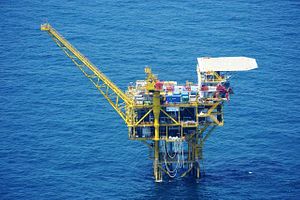It’s been a busy weekend in the East China Sea, where, starting Friday, multiple Chinese Coast Guard and fishing vessels entered waters disputed between China and Japan.
Japan has filed repeated protests with China over the coast guard vessels which entered territorial waters around the disputed Senkaku/Diaoyu Islands.
Adding to tensions in the East China Sea, a Japanese foreign ministry spokesman noted on Sunday that authorities in Tokyo discovered that China had installed radar equipment on a gas platform, near disputed waters.
According to the foreign ministry spokesperson, Japan determined that China had installed a radar earlier this summer, in late June.
Japan “cannot accept” the radar, the foreign ministry spokesman noted, according to the Wall Street Journal. “We call for the immediate removal of the equipment,” he said.
The Japanese discovery of a radar on board a gas platform has stoked fears that China may be converting its gas exploration platforms for partial military use.
According to the Japanese foreign ministry, China has at least 16 gas exploration platforms in East China Sea waters.
The approach would echo China’s artificial islands in the Spratly Islands in South China Sea, which Beijing claims are for non-military use.
Last September, for example, satellite imagery first published in The Diplomat showed the construction of a over-the-horizon radar on Cuarteron Reef.
Tokyo hasn’t specified what capabilities, including range, the Chinese radar may possess. As of this writing, the Chinese foreign and defense ministries have not commented on the Japanese protests about the radar.
In its report on the radar platform, the WSJ includes an image that “shows the Chinese offshore gas platform that Japan says has a radar facility.”
The same image is referenced as China’s “12th structure” in a slideshow (PDF) released on August 6 by the Japanese foreign ministry, showing Chinese gas exploration platforms in the East China Sea.
A map released by the Japanese foreign ministry shows this same 12th structure to be the northernmost of China’s platforms in the East China Sea, placing it further away from disputed waters than several other platforms.
Earlier this year, Japan activated a new radar station on Yonaguni Island in the East China Sea. Yonaguni is located 90 miles south of the disputed Senkaku/Diaoyu Islands and 62 miles east of Taiwan.
Japan is reportedly also planning to activate another radar station in 2017; its last defense budget emphasized intelligence, surveillance, and reconnaissance capabilities in the East China Sea.
Japan and China have yet to delimit the extent of their exclusive economic zones in the East China Sea.
Last summer, as I discussed in The Diplomat, Tokyo drew special attention to Chinese gas exploration activities in the East China Sea, arguing that Chinese efforts were in violation of a 2008 bilateral agreement for joint natural resource development.
The geographical equidistance line between the two countries in the East China Sea may ultimately end up as the final maritime delimitation, but Japan is concerned about potential Chinese exploitation of underwater natural gas fields that extend across the line.

































